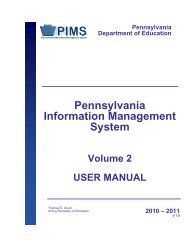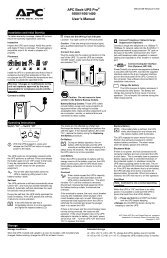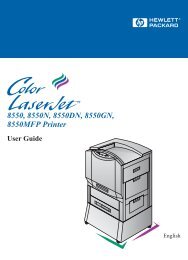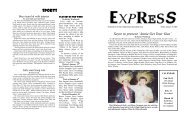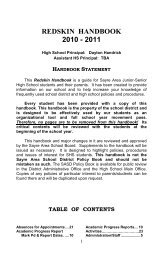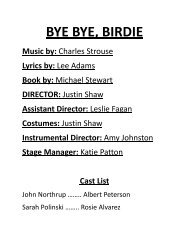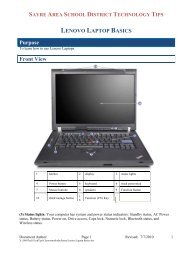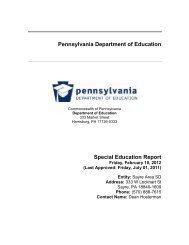PIMS Manual_Vol 1_V1.0 - Sayre Area School District
PIMS Manual_Vol 1_V1.0 - Sayre Area School District
PIMS Manual_Vol 1_V1.0 - Sayre Area School District
Create successful ePaper yourself
Turn your PDF publications into a flip-book with our unique Google optimized e-Paper software.
Pennsylvania Information<br />
Management System<br />
Pennsylvania<br />
Department of Education<br />
FAQs, continued<br />
7. What are the types of homeless situations?<br />
• The definition of “Primary Nighttime Residence” is the type of residence (e.g. shelter, doubled-up in the home of a relative or friend,<br />
unsheltered, or in a hotel/motel) where a homeless child or unaccompanied youth was staying at the time of enrollment or the type of<br />
residence where a currently enrolled child or youth was staying when he or she was identified as homeless.<br />
• Shelters: Supervised publicly or privately operated facilities designed to provide temporary living accommodations.<br />
• Transitional Housing: Temporary accommodation for homeless individuals and families provided as a step to permanent housing.<br />
Residents of transitional housing continue to be considered homeless until they move into permanent housing.<br />
• Awaiting Foster Care Placement: The McKinney-Vento Act does not define this term; however, many state and local child welfare<br />
agencies and education agencies have developed definitions of who is considered to be “awaiting foster care placement” in their state or<br />
locality. State and/or local definition should be the guide for determining this classification.<br />
• Doubled-Up: Living with another family. The McKinney-Vento Act defines this term as “sharing the housing of other persons due to loss<br />
of housing, economic hardship, or a similar reason” [725(2)(B)]. This classification particularly requires a case-by-case determination.<br />
o NOTE: The determining factor is whether the accommodation is a “fixed, regular, and adequate nighttime residence.”<br />
• Unsheltered: Includes cars, parks, campgrounds, temporary trailers, abandoned buildings, and substandard housing. Substandard<br />
housing may be determined by local building codes, community norms, and/or as a case-by-case determination as to whether the<br />
accommodation is a “fixed, regular, and adequate nighttime residence.” Because FEMA trailers are considered temporary trailers, FEMA<br />
trailers primary nighttime residence category would be “Unsheltered.”<br />
• Hotels/Motels<br />
Version 1 Page 117<br />
Published 7/21/2010




